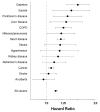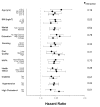Causes of Death Associated With Prolonged TV Viewing: NIH-AARP Diet and Health Study
- PMID: 26215832
- PMCID: PMC4656060
- DOI: 10.1016/j.amepre.2015.05.023
Causes of Death Associated With Prolonged TV Viewing: NIH-AARP Diet and Health Study
Abstract
Introduction: TV viewing is the most prevalent sedentary behavior and is associated with increased risk of cardiovascular disease and cancer mortality, but the association with other leading causes of death is unknown. This study examined the association between TV viewing and leading causes of death in the U.S.
Methods: A prospective cohort of 221,426 individuals (57% male) aged 50-71 years who were free of chronic disease at baseline (1995-1996), 93% white, with an average BMI of 26.7 (SD=4.4) kg/m(2) were included. Participants self-reported TV viewing at baseline and were followed until death or December 31, 2011. Hazard ratios (HRs) and 95% CIs for TV viewing and cause-specific mortality were estimated using Cox proportional hazards regression. Analyses were conducted in 2014-2015.
Results: After an average follow-up of 14.1 years, adjusted mortality risk for a 2-hour/day increase in TV viewing was significantly higher for the following causes of death (HR [95% CI]): cancer (1.07 [1.03, 1.11]); heart disease (1.23 [1.17, 1.29]); chronic obstructive pulmonary disease (1.28 [1.14, 1.43]); diabetes (1.56 [1.33, 1.83]); influenza/pneumonia (1.24 [1.02, 1.50]); Parkinson disease (1.35 [1.11, 1.65]); liver disease (1.33 [1.05, 1.67]); and suicide (1.43 [1.10, 1.85]. Mortality associations persisted in stratified analyses with important potential confounders, reducing causation concerns.
Conclusions: This study shows the breadth of mortality outcomes associated with prolonged TV viewing, and identifies novel associations for several leading causes of death. TV viewing is a prevalent discretionary behavior that may be a more important target for public health intervention than previously recognized.
Trial registration: ClinicalTrials.gov number, NCT00340015.
Published by Elsevier Inc.
Figures



Similar articles
-
Body mass index, physical activity, and television time in relation to mortality risk among endometrial cancer survivors in the NIH-AARP Diet and Health Study cohort.Cancer Causes Control. 2016 Nov;27(11):1403-1409. doi: 10.1007/s10552-016-0813-7. Epub 2016 Oct 11. Cancer Causes Control. 2016. PMID: 27730319 Free PMC article.
-
Television viewing time and mortality from stroke and coronary artery disease among Japanese men and women -- the Japan Collaborative Cohort Study.Circ J. 2015;79(11):2389-95. doi: 10.1253/circj.CJ-14-1335. Epub 2015 Sep 7. Circ J. 2015. PMID: 26346284
-
Television viewing time independently predicts all-cause and cardiovascular mortality: the EPIC Norfolk study.Int J Epidemiol. 2011 Feb;40(1):150-9. doi: 10.1093/ije/dyq105. Epub 2010 Jun 23. Int J Epidemiol. 2011. PMID: 20576628
-
The Dose-Response Associations of Sedentary Time with Chronic Diseases and the Risk for All-Cause Mortality Affected by Different Health Status: A Systematic Review and Meta-Analysis.J Nutr Health Aging. 2020;24(1):63-70. doi: 10.1007/s12603-019-1298-3. J Nutr Health Aging. 2020. PMID: 31886810
-
Interventions outside the workplace for reducing sedentary behaviour in adults under 60 years of age.Cochrane Database Syst Rev. 2020 Jul 17;7(7):CD012554. doi: 10.1002/14651858.CD012554.pub2. Cochrane Database Syst Rev. 2020. PMID: 32678471 Free PMC article.
Cited by
-
Joint Association of Screen Time and Physical Activity with Obesity: Findings from the Korea Media Panel Study.Osong Public Health Res Perspect. 2018 Aug;9(4):207-212. doi: 10.24171/j.phrp.2018.9.4.10. Osong Public Health Res Perspect. 2018. PMID: 30159227 Free PMC article.
-
Patterns of cancer-related health behaviors among middle-aged and older adults: Individual- and area-level socioeconomic disparities.Prev Med. 2018 Oct;115:31-38. doi: 10.1016/j.ypmed.2018.08.003. Epub 2018 Aug 3. Prev Med. 2018. PMID: 30081135 Free PMC article.
-
Psychological-health correlates of physical activity and sedentary behaviour during the COVID pandemic.Ment Health Phys Act. 2022 Oct;23:100481. doi: 10.1016/j.mhpa.2022.100481. Epub 2022 Nov 15. Ment Health Phys Act. 2022. PMID: 36406837 Free PMC article.
-
Psycho-Physiological Effects of Television Viewing During Exercise.J Sports Sci Med. 2016 Aug 5;15(3):524-531. eCollection 2016 Sep. J Sports Sci Med. 2016. PMID: 27803632 Free PMC article.
-
Development and validation of a nomogram to predict depression in older adults with heart disease: a national survey in China.Front Public Health. 2024 Dec 11;12:1469980. doi: 10.3389/fpubh.2024.1469980. eCollection 2024. Front Public Health. 2024. PMID: 39722705 Free PMC article.
References
-
- Neilson Reports. Households with Televisions. 2013 http://www.nielsen.com/us/en/insights/news/2013/nielsen-estimates-115-6-....
-
- Bureau of Labor and Statistics. American Time Use Survey. 2012 www.bls.gov/tus/tables/a1_2013.pdf.
-
- Grontved A, Hu FB. Television viewing and risk of type 2 diabetes, cardiovascular disease, and all-cause mortality: a meta-analysis. JAMA. 2011;305(23):2448–2455. http://dx.doi.org/10.1001/jama.2011.812. - DOI - PMC - PubMed
-
- Wijndaele K, Brage S, Besson H, et al. Television viewing time independently predicts all-cause and cardiovascular mortality: the EPIC Norfolk study. Int J Epidemiol. 2011;40(1):150–159. http://dx.doi.org/10.1093/ije/dyq105. - DOI - PubMed
-
- Matthews CE, George SM, Moore SC, et al. Amount of time spent in sedentary behaviors and cause-specific mortality in U.S. adults. Am J Clin Nutr. 2012;95(2):437–445. http://dx.doi.org/10.3945/ajcn.111.019620. - DOI - PMC - PubMed
Publication types
MeSH terms
Associated data
Grants and funding
LinkOut - more resources
Full Text Sources
Other Literature Sources
Medical

